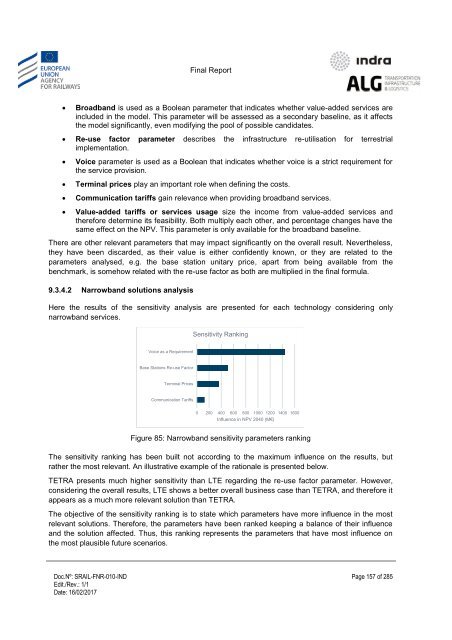Study on feasibility of SATCOM for railway communication
SRAIL-FNR-010-IND%20-%20FinalReport_v1.1_20170216
SRAIL-FNR-010-IND%20-%20FinalReport_v1.1_20170216
You also want an ePaper? Increase the reach of your titles
YUMPU automatically turns print PDFs into web optimized ePapers that Google loves.
Final Report<br />
<br />
Broadband is used as a Boolean parameter that indicates whether value-added services are<br />
included in the model. This parameter will be assessed as a sec<strong>on</strong>dary baseline, as it affects<br />
the model significantly, even modifying the pool <strong>of</strong> possible candidates.<br />
Re-use factor parameter describes the infrastructure re-utilisati<strong>on</strong> <strong>for</strong> terrestrial<br />
implementati<strong>on</strong>.<br />
<br />
<br />
<br />
<br />
Voice parameter is used as a Boolean that indicates whether voice is a strict requirement <strong>for</strong><br />
the service provisi<strong>on</strong>.<br />
Terminal prices play an important role when defining the costs.<br />
Communicati<strong>on</strong> tariffs gain relevance when providing broadband services.<br />
Value-added tariffs or services usage size the income from value-added services and<br />
there<strong>for</strong>e determine its <strong>feasibility</strong>. Both multiply each other, and percentage changes have the<br />
same effect <strong>on</strong> the NPV. This parameter is <strong>on</strong>ly available <strong>for</strong> the broadband baseline.<br />
There are other relevant parameters that may impact significantly <strong>on</strong> the overall result. Nevertheless,<br />
they have been discarded, as their value is either c<strong>on</strong>fidently known, or they are related to the<br />
parameters analysed, e.g. the base stati<strong>on</strong> unitary price, apart from being available from the<br />
benchmark, is somehow related with the re-use factor as both are multiplied in the final <strong>for</strong>mula.<br />
9.3.4.2 Narrowband soluti<strong>on</strong>s analysis<br />
Here the results <strong>of</strong> the sensitivity analysis are presented <strong>for</strong> each technology c<strong>on</strong>sidering <strong>on</strong>ly<br />
narrowband services.<br />
Sensitivity Ranking<br />
Voice as a Requirement<br />
Base Stati<strong>on</strong>s Re-use Factor<br />
Terminal Prices<br />
Communicati<strong>on</strong> Tariffs<br />
0 200 400 600 800 1000 1200 1400 1600<br />
Influence in NPV 2040 (M€)<br />
Figure 85: Narrowband sensitivity parameters ranking<br />
The sensitivity ranking has been built not according to the maximum influence <strong>on</strong> the results, but<br />
rather the most relevant. An illustrative example <strong>of</strong> the rati<strong>on</strong>ale is presented below.<br />
TETRA presents much higher sensitivity than LTE regarding the re-use factor parameter. However,<br />
c<strong>on</strong>sidering the overall results, LTE shows a better overall business case than TETRA, and there<strong>for</strong>e it<br />
appears as a much more relevant soluti<strong>on</strong> than TETRA.<br />
The objective <strong>of</strong> the sensitivity ranking is to state which parameters have more influence in the most<br />
relevant soluti<strong>on</strong>s. There<strong>for</strong>e, the parameters have been ranked keeping a balance <strong>of</strong> their influence<br />
and the soluti<strong>on</strong> affected. Thus, this ranking represents the parameters that have most influence <strong>on</strong><br />
the most plausible future scenarios.<br />
Doc.Nº: SRAIL-FNR-010-IND<br />
Edit./Rev.: 1/1<br />
Date: 16/02/2017<br />
Page 157 <strong>of</strong> 285


